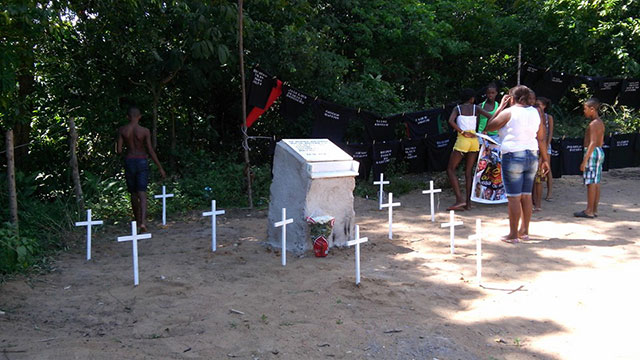
Police violence does not end when someone dies in a confrontation. The kindred of the dead suffer for years to come – a lingering, constituent facet of this terror. We need only recall Ferguson, Missouri.
In Brazil, police violence haunts as well; especially in working-class Black neighborhoods where the affective communities of the dead mourn under the threat of reprisal from the police.
On February 27, 2016, residents of Vila Moises in Salvador, Bahia, Brazil, gathered to pay tribute to12 young Black men killed by the police one year earlier. On February 6, 2015, the Special Operations Unit of the Bahian Military Police (RONDESP) invaded Vila Moises, rounded up a groupof young residents, took them to a remote location, tortured them, killed 12 and wounded four. The victims were between the ages of 15 and 27.
The killings came to be known as the Cabula Massacre (named for the neighborhood where Vila Moises is located). It was one of the deadliest police actions in recent Bahian history.
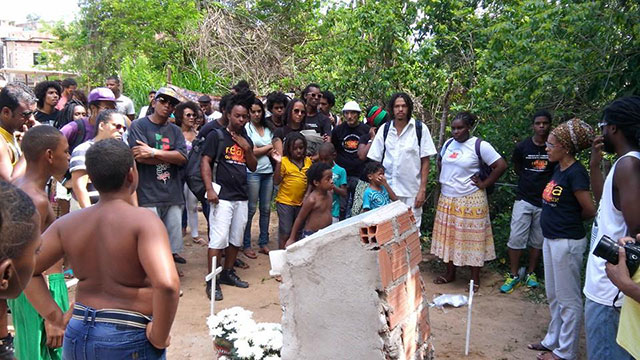 Community members from Vila Moises stand with organizers from React or Die! and Quilombo Xis at the memorial to the Cabula 12. (Photo: Lena Azevedo)
Community members from Vila Moises stand with organizers from React or Die! and Quilombo Xis at the memorial to the Cabula 12. (Photo: Lena Azevedo)
On February 27, 2016, Vila Moises held an all-day tribute to “The Twelve” (Doze). The memorial was co-organized with Quilombo Xis, a community action network that is affiliated with React or Die!/React or Be Killed! – a campaign to fight the genocide of Black people in Brazil. It included acommunity teach-in, hair braiding workshop and a hip-hop performance. But despite its innocuous family-friendly tone, residents who attended did so in fear.
Ever since February 2015, intimidation and death threats have haunted Vila Moises. When residents gather to protest or mourn, the police retaliate. In August 2015, the community erected a memorial to The Twelve on the spot where they were killed. Police officers occupied the neighborhood and intimidated residents during the days surrounding the event, which was tied to React or Die!’s annual March Against the Genocide of Black People. On February 6, 2016 – the one-year anniversary of the Cabula Massacre – React or Die! once again joined forces with Vila Moises to commemorate The Twelve. On February 18, police murdered six more young Black men in Cabula, this time in the community of Engomadeira.
Mourning the dead is often a dangerous game.
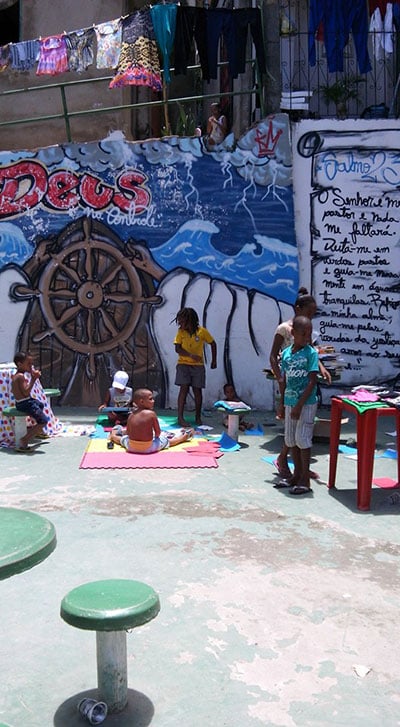 Residents are calling on the international community to demand the Brazilian government open a federal investigation of the Cabula Massacre and stop the police campaign of intimidation.
Residents are calling on the international community to demand the Brazilian government open a federal investigation of the Cabula Massacre and stop the police campaign of intimidation.
The RONDESP officers who invaded Vila Moises in February 2015 initially claimed that killings happened in a shootout, with so-called “criminals” hoarding arms and planning to rob a bank. But witnesses maintained that the young people were taken one by one, brutalized, made to get down on their knees and shot with their hands up.
Shortly after the killings, organizers from React or Die! and Vila Moises went to the morgue todocument the murders. There, they found the young men’s bodies riddled with bullets and curiously dressed in military fatigues. They soon discovered an intricate web of deceit that grated against RONDESP’s story.
In a media exposé, Brazilian journalists traveled to the crime scene with activists to find shell casings,bloody clothes with bullet holes and latex gloves strewn on the ground – proof that police had done a shoddy forensic investigation. The clothes they found answered lingering questions about the military fatigues found on the corpses: The police removed the young men’s clothes to hide the fact that they had been tortured and executed.
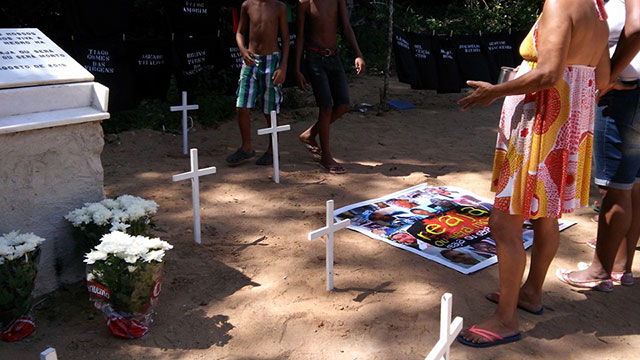 Residents look down on the 12 white crosses and a memorial banner at the site where 12 Black men were killed in the Cabula Massacre. (Photo: Lena Azevedo)
Residents look down on the 12 white crosses and a memorial banner at the site where 12 Black men were killed in the Cabula Massacre. (Photo: Lena Azevedo)
In the subsequent investigation, Bahia’s state prosecutor concurred that the 12 men had been assassinated. The police officers were not convicted, however.
In July 2015, Judge Marivalda Almeida Moutinho exonerated the RONDESP officers, keeping in line with the state’s official stance on the killings. Just after the massacre, Gov. Rui Barbosa likened thepolice officers who killed the youth to those who play the “attack” (artilheiro) position in a soccer match. In other words, the governor believes killing Black youth is a necessary strategy to win the game of “crime.”
Captain Tadeu Nascimento Fernandes, a well-known police spokesperson from Bahia, lauded Judge Moutinho’s decision, affirming that the RONDESP officers acted appropriately. For him, the role of the police is to “clean up trash.”
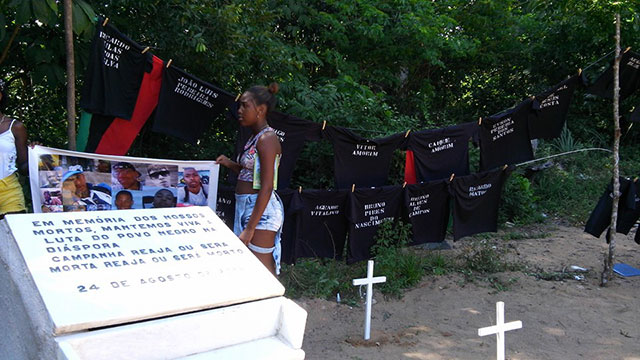 Two residents of Vila Moises stand by a banner with the pictures of the victims of the Cabula Massacre alongside black t-shirts that bear each victim’s name. (Photo: Lena Azevedo)
Two residents of Vila Moises stand by a banner with the pictures of the victims of the Cabula Massacre alongside black t-shirts that bear each victim’s name. (Photo: Lena Azevedo)
To be sure, the state views police violence as a necessary security measure. But this approach to”preventative” crime control is a brutal counterpoint to Brazil’s official position against the death penalty. The notion of executing first and investigating later is not only against the Brazilian Constitution, but also a clear human rights violation. However, police executions are commonplace throughout the nation. They are also clearly race- and class-based. Disproportionately, the victims of police violence in Brazil are poor Black youth. In the eyes of the police, poor Black people are the “trash” of Brazilian society.
Federal investigation is one of the only viable pathways to holding the RONDESP officers accountable for the Cabula massacre. React or Die! co-coordinator Hamilton Borges Walê states, “Only a federal investigation of the Cabula case will hold the cops accountable; taking the case to the federal level may help stop them from murdering Black people daily in Bahia.” React or Die! and Vila Moises are asking the international community to call on the Brazilian government to federally investigate the Cabula Massacre. They are also praying that future tributes won’t bring more death.
Join us in defending the truth before it’s too late
The future of independent journalism is uncertain, and the consequences of losing it are too grave to ignore. To ensure Truthout remains safe, strong, and free, we need to raise $50,000 in the next 9 days. Every dollar raised goes directly toward the costs of producing news you can trust.
Please give what you can — because by supporting us with a tax-deductible donation, you’re not just preserving a source of news, you’re helping to safeguard what’s left of our democracy.